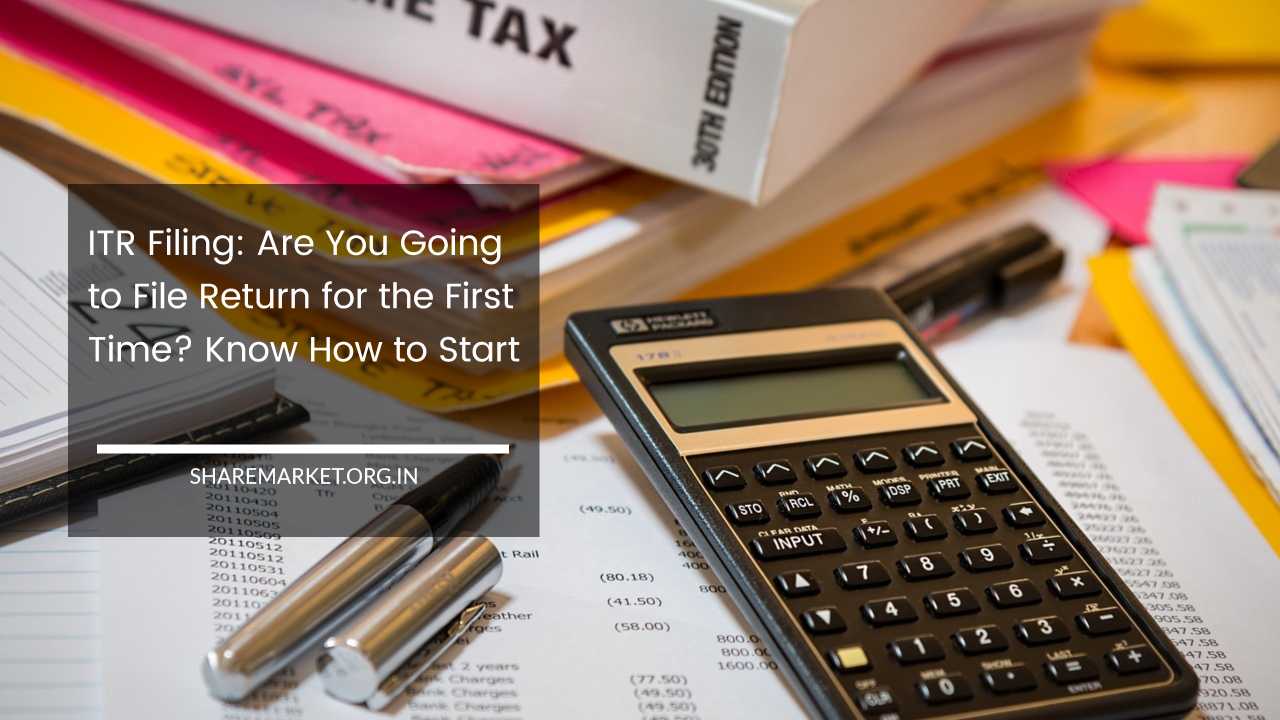ITR Filing: Are You Going to File Return for the First Time? Know How to Start

ITR Filing
According to the provisions of the Income Tax Act, 1961, individuals are required to file an income tax return if their income surpasses the basic exemption limit.
In the financial year 2022-23, if an individual’s annual income exceeds Rs 2.5 lakhs and their age is 60 years or below, it becomes mandatory for them to file an income tax return.
One of the scenarios where filing an income tax return becomes necessary is when an individual incurs a capital loss during a financial year and wishes to carry it forward.
By filing an income tax return, individuals can declare their capital loss and carry it forward to offset against any positive income in subsequent years.
This provision allows individuals to maximize their tax benefits and minimize their tax liability in the long run.
Furthermore, if an individual’s credit card expenses or foreign travel expenses exceed a certain limit, it also becomes mandatory for them to file an income tax return.
The specifics of these limits may vary and are subject to the provisions outlined in the Income Tax Act and any relevant notifications issued by the tax authorities.
Filing an income tax return in these circumstances helps ensure compliance with the law and facilitates the reporting of financial transactions that may have implications for taxation. It allows the tax authorities to assess the individual’s income, expenses, and tax liability accurately.
It’s important to note that the income tax filing requirements and exemptions can vary based on different factors, such as age, income sources, and other specific circumstances.
It is advisable to consult a tax professional or refer to the official guidelines and provisions of the Income Tax Act to determine the precise requirements applicable to an individual’s situation.
If you are filing your Income Tax Return (ITR) for the first time, it is important to note that the process will be done electronically through the Income Tax website, also known as e-filing.
This electronic mode of filing is mandatory for most individuals, except for super senior citizens who are 80 years old and above. Super senior citizens have the option to file their returns in paper mode if specific conditions are met.
For individuals other than super senior citizens, online filing is a requirement. To file your ITR online, you must have an account on the Income Tax e-Filing Portal.
This portal serves as the platform for taxpayers to electronically file their returns and manage other tax-related activities.
To begin the online ITR filing process, you can visit the official website of the Income Tax Department at https://www.incometax.gov.in/iec/foportal/.
This website provides a user-friendly interface and comprehensive guidance to assist you in the process of filing your income tax return online.
It is important to ensure that you have all the necessary documents, such as your Form 16 (issued by your employer), bank statements, investment details, and other relevant financial records, before initiating the e-filing process.
These documents will be required to accurately report your income, deductions, and other details on your income tax return.
By filing your ITR online, you can benefit from the convenience and efficiency offered by electronic filing. It enables faster processing of your return, reduces the chances of errors, and provides a secure method of submitting your tax information to the tax authorities.
While the general process of e-filing remains consistent, it is always advisable to refer to the official guidelines and instructions provided by the Income Tax Department or seek professional advice to ensure compliance with the latest requirements and procedures for filing your ITR electronically.
Who is Required to File Return?
As per the provisions of the Income Tax Act, 1961, several factors determine whether an individual is required to file an income tax return. Here are the key requirements based on the financial year 2022-23:
1. Basic Exemption Limit: If an individual’s annual income exceeds the basic exemption limit, filing an income tax return becomes necessary. For individuals below 60 years of age, the basic exemption limit is Rs 2.5 lakhs.
2. Age-Specific Exemption Limits:
– Individuals between 60 and 80 years of age: If their annual income exceeds Rs 3 lakhs, they are required to file an income tax return.
– Super senior citizens (above 80 years): If their annual income exceeds Rs 5 lakhs, they must file an income tax return.
3. Capital Loss Carryforward: If an individual incurs a capital loss in a financial year and intends to carry it forward for setting it off against positive income in subsequent years, they need to file an income tax return. This allows them to avail of the benefit of carrying forward capital losses.
4. Credit Card or Foreign Travel Expenses: If an individual’s credit card expenses or foreign travel expenses exceed a specific limit, it becomes necessary for them to file an income tax return. The limits for these expenses are determined by the provisions of the Income Tax Act and any relevant notifications issued by the tax authorities.
It’s crucial to note that these requirements may vary based on different financial years, amendments to tax laws, and individual circumstances.
It is advisable to consult a tax professional or refer to the official guidelines provided by the Income Tax Department to ascertain the specific income threshold and filing requirements applicable to your situation.
Filing an income tax return ensures compliance with tax regulations, facilitates accurate reporting of income, deductions, and expenses, and allows individuals to take advantage of various benefits, such as carrying forward losses and claiming refunds, if eligible.
How to Create E-filing Account?
To create an e-filing account on the Income Tax Department’s e-filing portal, please follow these steps:
- Visit the e-filing portal of Income Tax by accessing the URL mentioned above.
- On the top right-hand side of the portal, you will find a ‘register’ tab. Click on it to begin the registration process.
- Provide your PAN (Permanent Account Number) when prompted. The PAN will be validated for authentication purposes.
- Confirm your status as an ‘Individual Taxpayer’.
- Enter your name as per your PAN card, and confirm your gender and residential status.
- Provide a valid mobile number and email ID. These details will be used for the verification process and future communication.
- In the third step, enter your postal address accurately.
- Create a strong password for your e-filing account.
- Click on ‘Continue’ to proceed with the registration process.
- You will receive two separate six-digit One-Time Passwords (OTP1 and OTP2). These will be sent to the mobile number and email ID provided during registration.
- Enter the OTPs received in the respective fields to verify your mobile number and email ID.
- Once you enter the OTPs, the registration process will be completed, and your e-filing account will be created.
After successfully creating your e-filing account, you will be able to log in using your PAN and the password you set during the registration process.
This account will allow you to file your income tax returns, track the status of your returns, access tax-related documents, and perform various other tax-related activities conveniently through the e-filing portal.
E-filing Vault for Enhanced Security
After creating your e-filing account, it is highly recommended to set up the e-filing vault to enhance the security of your financial information.
The e-filing vault provides an additional layer of protection against unauthorized access. When the e-filing vault is enabled, you will be required to use a One-Time Password (OTP) each time you access your e-filing account.
To activate the e-filing vault, follow these steps:
- Access your e-filing account and navigate to the ‘Profile Settings’ tab.
- Look for the option ‘e-filing with higher security’ and click on it.
- You will be presented with various security options to choose from.
- Select one or more security options that you prefer. These options could include Aadhaar-based authentication, Net Banking-based authentication, or Digital Signature Certificate (DSC) authentication.
- Depending on your chosen option, you may need to log in to your respective account. For example, if you select Net Banking, you will be redirected to your net banking portal to complete the authentication process.
Once you have set up the e-filing vault and selected your preferred security options, the next time you log in to your e-filing account, you will need to go through the additional authentication step using the chosen method.
In addition to accessing and filing tax returns, your e-filing account can be utilized for various other purposes. Some examples include:
- Downloading previous tax returns.
- Accessing Form 26AS (which provides details of tax deducted on your behalf by deductors).
- Viewing the Annual Information Statement (AIS) that contains details of high-value financial transactions reported to the Income Tax Department.
Your e-filing account can also be used for resolving issues related to registration on the e-filing portal, applying for a PAN, and performing other related tasks. It serves as a centralized platform for managing your tax-related activities conveniently and securely.
It is important to regularly update and maintain the security features of your e-filing account to safeguard your sensitive financial information.

















